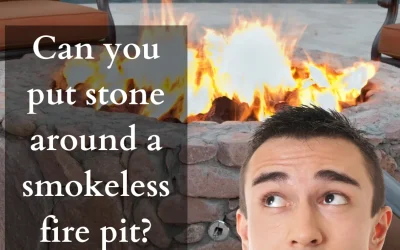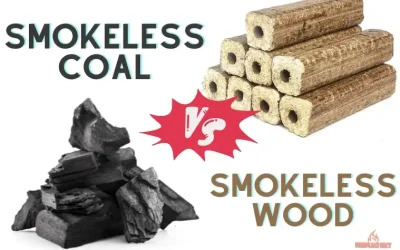You may want to spend some quality time with your friends, and family this winter, make memories, enjoy conversations while enjoying an outdoor view.
But at the same time, you may want to enjoy a smokeless, clean fire ambiance without much maintenance, and trouble.
Your wood burning fire pit won’t allow you to have all the privileges you are seeking for. Fire pits that run on wood, or logs, produce significant amounts of smoke because of the incomplete burning process. It may potentially bother you and your clothes may smell like a campfire. It may also leave a mess for you after the burning which can really kill your spirit.
Propane fire pits can solve your problem while offering you lots of benefits to make your winter experience a lot better, and easier.
If you already own a wood burning fire pit, you can convert it to propane, and enjoy the privileges without spending much.
Here, we are going to help you with a complete guide on how to convert a wood fire pit to propane. We will also provide you all the necessary information you may need while converting.
Converting Wood Burning Fire Pit To Gas
To make your experience of converting easier, follow these instructions, and convert your wood fire stove to propane without much hassle!
Step 1: Switch Your Fuel Type
If you are planning to convert your wood burning fire pit to propane, the first thing you need to do is change the fuel type of your fire product. Now, if you switch to liquid propane, you can usually run your fire with a 20-pound propane tank. You can quickly and easily set it up, and connect it to the main line.
Now, you need to prepare your burner for the new fuel type which is propane.
Step 2: Choose Your Fire Pit’s Ignition System
The first step to preparing your fire stove for propane is to select its ignition system.
There are different types of ignition systems for your burner to choose. The three main types of ignitions: Match Lit, Push Button/Spark, and Electronic will work smoothly and continuously with your fire stove.
Here’s a brief description of the above mentioned ignition types:
Match Lit Ignition

It is the traditional method to ignite a fireplace. You need to light the flames manually by holding a matchstick or a long lighter near the burner before opening the gas valve. A match lit ignition system has little to no moving parts, meaning less maintenance is required.
Simply put, turn the key valve, light the burner (preferably with a long stem lighter), and you’re ready to go.
You don’t need any special equipment for this ignition system.
Push Button Ignition
It is similar to the spark ignition system of a gas grill. Simply turn the key valve, push the button, and you’re ready to enjoy your fire pit.
It is usually powered by battery, and the battery is neatly hidden in the Push Button Unit itself. When you press the button, it sends a small electric current to an Ignition Probe that is mounted close to the fire pit burner. This is basically the same as lighting a gas ring on a gas hob.
Electronic Ignition
In most of the Electronic Ignition System, you will get to monitor the flame of the fire pit and cut off the gas flow if the flame is accidentally extinguished. It is the most convenient one as you will be able to turn your fire appliance on remotely or add features like a timer or emergency stop.
You should keep in mind that this type of ignition requires electricity at the fire appliance.
Choose the ignition system of your burner according to your preference and convenience.
Step 3: Ensure Sufficient Ventilation
After you are done with the ignition system, you need to make sure your fire pit is well ventilated to allow it a complete burning process.
You need to maintain a 36 square inches of ventilation to create proper air flow within your fire pit for propane gas. It will ensure your fire pit gases combust properly and avoid pooling.
Additionally, you need 18 square inches of ventilation on the opposing side. Opposing vents help create cross ventilation. In this case, the propane gets a place to escape. One of the advantages of the crossfire fire pit is that you do not need an air mix or valve.
It is important to keep your fire pit properly ventilated if you are converting it to propane. To ensure proper airflow, you need to place a single 2-inch hole every 24 to 36 inches around the base of the pit. The number of the holes may vary size to size of your fire pit.
Make sure you clean and keep those holes cleared of any debris, or mess.
Another important thing to note, avoid using plastic pipes or PVC for air holes. They can compromise the compressed air system of your burner.
Step 4: Set Up Fire Pit Pan
To complete the converting process, you need to set up a fire pit pan.
A properly mounted burner pan can make the fire pit burning ring highly durable and also increase the performance of it.
It can help with a proper drainage, keep everything in your fire pit drier, and also make the maintenance easier for you. It will also allow you to buy less fillers for your fire product.
For liquid propane applications, a fire pit pan is a necessary attachment. It will make the access to gas lines easier if you ever need to repair the fire stove.
Try to use a flat pan in combination with installation collars. Once it is installed, you are ready to move to the next step.
Step 5: Install Key Valve

A key valve allows you to light the fire pit for a match light system, control the gas flow and can also be used as an emergency shut-off for electronic ignition kits.
The valve will be on the inside of your fire pit enclosure and the decorative flange extension on the outside.
You can hire a professional installer, or a worker from any servicing store to set it up. If you want to do it yourself, you may look into video tutorials on the internet.
Step 6: Select Decorative Fillers For Your Burner

Now that you are done with all the necessary steps of converting your wood burner to propane, it’s time for the finishing touch.
Adding fillers to your fire pit will allow you a safe way to create drainage and make your fire appliance look nicer. While some of you may choose to forgo a filler and simply use a concrete or stone base, filler can add a nice aesthetic to your fireside that can enhance the beauty of the fire ambiance.
You can use fire rated glass, natural lava rock, or lava beads as decorative fillers for your burner. Fire glass is safe to use in a variety of places. Using it in a fire pit or fireplace that uses propane is ideal.
Fire glass is meant to withstand extreme temperatures, cracking, and color changing when used with proper gas. Curious to know more about how it works? Check this blog on how a fire glass works with detailed information.
However, you need to follow additional instructions given with the fire glass to safely use it with propane fire pits.
You can go through this guidebook on how to install fire glass in a fire pit to add it to your fire ambiance like an expert!
Some materials like hard rock, gravel, or sand weren’t meant to reach high temperatures and can spark and explode if your fire gets too hot. So, while using propane, you should go for lava rocks or lava glass beads as a filler for your fire pit.
If you opt for lava rocks as your burner’s filler, here are some additional instructions for you on how to use lava rocks for your fire pit.
After adding the fillers,your conversion process will be complete. Now you are set to go!
You may also like: The Best Rocks for Fire Pit
Reasons for Converting
Having a firepit that runs on wood, or logs might offer you warmth, and the traditional vibe. However, it also comes with a lot of disadvantages, and hassle. Wood burning pits are harder to light, need constant attention and effort to keep it burning, and always leave quite a mess for you to clean after burning.
They are also larger in size, and you may need more space for storing wood.
Wood burning chimneys are harder to maintain and clean. You need to clean them regularly for getting a long time service.
Apart from all these troubles, there is a major drawback of using wood burning stoves. They can quickly start fire anywhere if you turn your attention elsewhere, and can cause fire hazards.
If you are an environmentally friendly person, and choose safety and convenience over everything else, you should definitely opt for propane fire pit. You can ensure your family, and friends a safe and comforting environment by making this life-changing decision.
Benefits of Converting
If you convert to a propane fire pit, it will completely change your fire experience. Propane fire stoves are usually designed with a secondary combustion system and produce zero to little smoke. They are also spark-free. So, you will have the lowest chances of facing fire hazards.
They are very user-friendly. You can quickly light them, and operate them very easily. They will run continuously without your much effort, or attention. To make your experience smoother, they will give you a clean burning and won’t leave any debris, logs, or mess for you.
There are a few other advantages for you if you go for Propane fire pits. They will give you higher fuel efficiency and save your money. They come in smaller sizes, and won’t take up much space at your desired spot.
On top of that, you will have a safe environment for you, and your close ones.
You won’t regret converting from a wood to propane fire appliance as it’s gonna offer you much more than what you will invest.
Cost of Converting
Converting to propane fire products will save your money and also be cost effective for you.
A propane line will usually cost you between $1,000 and $1,500. On the other hand, a natural gas line may cost you between $3,000 and $4,000.
You may need to spend a few dollars more for the service charge to setup your propane line.
To get done with the conversion, getting a conversion kit will make your experience a lot easier. It includes almost everything you need to complete the conversion, such as the burner ring, igniter, fire pit pan etc.
Kits usually cost from $2,500 to $3,000.
It will take you around 2-4 days to complete the entire conversion process.
Conclusion
Converting from a wood burning stove to propane will certainly offer you a lot of benefits and convenience such as, higher efficiency and heat output, easy maintenance, longer durability, and many more. However, you need to note that all the connections should be made by a qualified installer to ensure safety. A safe installation is important because it will allow you to operate your fire pit safely and easily.
Thank you for reading it so far. Did it help you anyway with the conversion process? Have you found the information you were looking for? We will be glad to hear your feedback. If you have any further questions regarding converting, installing, or any other issue, feel free to ask questions in the comments below.
What are you waiting for? Enjoy the fire ambiance, and make pleasant memories this winter with your converted propane fire pit!


